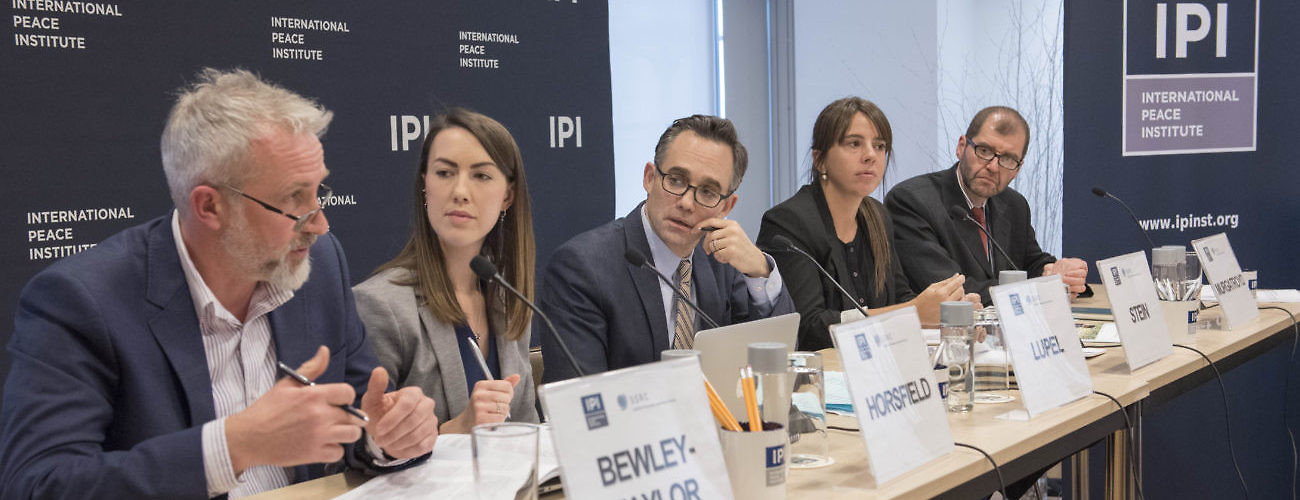Addressing concern that current drug policy can have a negative effect on communities and run counter to the Sustainable Development Goals (SDGs), IPI and the Conflict Prevention and Peace Forum held a policy forum on February 22nd on how drug policy can be better aligned with the SDGs so as to enhance both.
Setting the tone of the discussion, David Bewley-Taylor, Personal Chair, Political and Cultural Studies of Swansea University, said, “Effective drug policy and sustainable development are both international priorities that should work in tandem.”
Dr. Bewley-Taylor was speaking as one of the authors of a report being launched at the forum that argues that we need to change the ways in which we measure the success of drug policy to accurately account for its impact on society as a whole. “If current drug policies are found to exacerbate gender inequality or hinder peace, they need to be re-examined,” he said.
Current metrics used to evaluate drug policy are largely “process-oriented,” he said, measuring intermediary values rather than outcomes, which poses a challenge in explaining causation.
As drug metrics are already extremely nuanced, reforming them will be a challenge, albeit a necessary one, he conceded. The current system “largely fails” to capture data on broader harms, he said. To gain a more comprehensive overview of the impact of drug policy, the framework’s “complexity needs to be acknowledged and embraced.”
He proposed a tagline, which echoes that of the 70th anniversary of the United Nations Statistical Commission. Instead of “better data, better lives,” Dr. Bewley-Taylor suggested, “We need to extend that to ‘better and different data, better lives.’”
Co-author Natasha Horsfield, Policy and Advocacy Officer, Health Poverty Action, further argued the need for a new framework to measure the impact of drug policy on the success of SDGs. “The SDG framework offers an example and an opportunity in this regard,” she said.
This framework, comprehensive in its provision of 244 indicators and over 169 targets, “can serve as a starting point for adapting and developing similarly ambitious drug metrics,” said Ms. Horsfield. She explained that it could provide more accurate data on the impacts of drug policy on individual communities and could be used to tailor indicators to measure data at a national level.
Addressing the concern that drug policy has not been developed in concert with the SDGs, Sabrina Stein, Program Manager of the Conflict Prevention and Peace Forum and co-author of the report, echoed Ms. Horsfield. “It’s evident that drug policy cannot be designed in a vacuum,” she said.
Ms. Stein described six concrete recommendations from the paper that would enable this mutual consideration. First, she noted that it would be imperative to develop a framework for policy coherence; next, to create an external advisory committee. Then, to enhance drug policy metrics, the report makes the recommendation to add SDG indicators related to drug policy and to put in place mechanisms to gather data on the effects of drug policies. Finally, the report urges policymakers to use the SDG indicators as a model for improving drug policy indicators, and prioritize outcome-oriented methods.
On the international context of the report and the efficacy of its recommendations, Chris Murgatroyd, Policy Advisor, Governance & Peacebuilding Cluster, Bureau for Policy & Programme Support, United Nations Development Programme (UNDP), said that the report has been a welcome contribution to dialogue on sustainable development. “UNDP, you won’t be surprised to hear, has been very pleased to be part of discussions already in this space,” he said.
Summarizing the discussion, Adam Lupel, IPI Vice President, who moderated the talk, said, “If drug policy and the 2030 agenda are not aligned, the SDGs are really at risk of not being achieved.”








